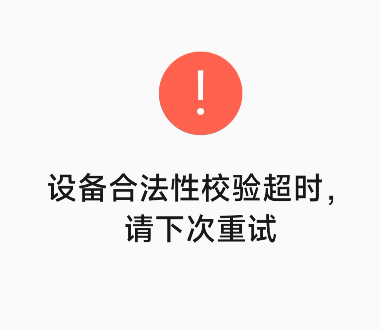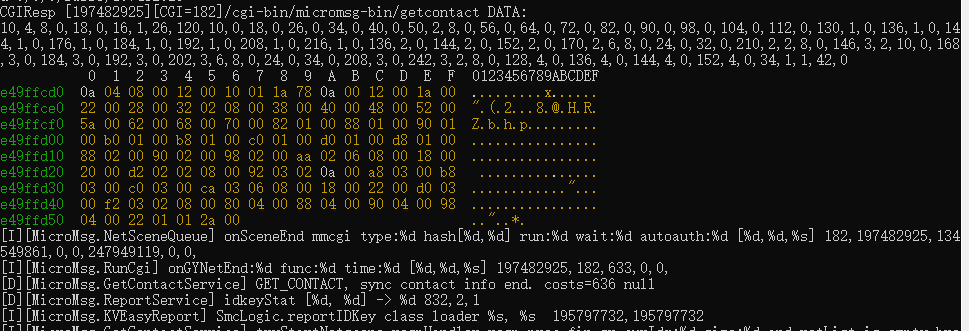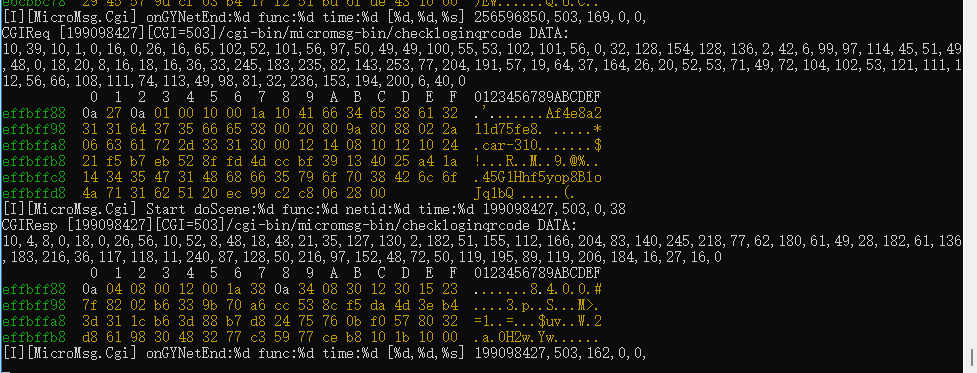又上学回来了(我讨厌高中). . . . . . 呃然后, 最近对微信协议有点兴趣, 所以研究一下
前言
由于微信客户端(不是小程序)请求加密走的是mmtls而不是标准TLS, 因而导致所有抓包软件均无法正常抓到微信请求, (这就导致我们是难以看到微信内部请求逻辑的).
因此, 本文使用Frida 微信Java层Hook发/收包的方法实现对其请求的抓包.
车载微信版本: wechat-v1.0.13.0.2472-release-202111232123
本文仅用于学习交流,严禁用于非法用途
屏蔽设备校验
如果你在正常手机上使用车载版的微信的话, 你首先得解决这个问题:

使用Jadx打开APK文件, 在资源中搜索"合法性"将会得到:

我们不难看到"设备合法性校验中"的name是ash, 在Jadx中搜索.ash可以找到这里:
package com.tencent.mm.ui;
public class LauncherFloatView extends FloatView {
/* ...... */
static void a(LauncherFloatView launcherFloatView, boolean z, boolean z2, int i) {
com.tencent.mm.sdk.platformtools.n.i("MicroMsg.LauncherFloatView", "ilink auth result: auth_get_result:" + z + " if_auth_pass:" + z2 + " err_code:" + i);
if (launcherFloatView.fCT) {
launcherFloatView.fCT = false;
if (!z2) { // 验证失败
launcherFloatView.b(false, false, z ? launcherFloatView.getResources().getString(R.string.asf) + "(" + i + ")" : launcherFloatView.getResources().getString(R.string.asg));
} else if (launcherFloatView.aaw()) { // 验证通过
launcherFloatView.b(false, true, "");
launcherFloatView.aat(); // 这个不能忘哦
}
}
}
// 当z为true时提示"合法性校验中", z2为true时提示"扫码登录微信"
private void b(boolean z, boolean z2, String str) {
if (z) {
aax();
aaC();
((TextView) this.fCF.findViewById(R.id.sq)).setText(R.string.ash);
a(this.fCF.findViewById(R.id.sn), this.fCQ);
this.fCF.setVisibility(0);
return;
}
if (z2) {
aax();
aaC();
((TextView) this.fCF.findViewById(R.id.sq)).setText(R.string.bfn);
bS(this.fCF.findViewById(R.id.sn));
this.fCF.setVisibility(8);
return;
}
if (!this.fCU) {
this.fCU = true;
aax();
p.a(str, "", null, null, false);
}
}
}看到这顿时就豁然开朗了, 只要直接让他调用aat就可以了, 校验解决!
Java.perform(function () {
let LauncherFloatView = Java.use("com.tencent.mm.ui.LauncherFloatView");
LauncherFloatView["b"].overload('boolean', 'boolean', 'java.lang.String').implementation = function (z, z2, str) {
console.log(`LauncherFloatView.b is called: z=${z}, z2=${z2}, str=${str}`);
this["b"](false, true, str);
this.aat()
};
})获取日志
那么从哪入手呢? 留意一下刚才的代码吧!
package com.tencent.mm.ui;
public class LauncherFloatView extends FloatView {
/* ...... */
static void a(LauncherFloatView launcherFloatView, boolean z, boolean z2, int i) {
com.tencent.mm.sdk.platformtools.n.i("MicroMsg.LauncherFloatView", "ilink auth result: auth_get_result:" + z + " if_auth_pass:" + z2 + " err_code:" + i);
}
}看到这里的日志了吗, 像这样的日志无处不在哦, 我们只要Hook一下下能看到日志了~
跟过去看一下:
package com.tencent.mm.sdk.platformtools;
public final class n {
/* ... */
public static void i(String str, String str2) {i(str, str2, null);}
public static void d(String str, String str2) {d(str, str2, null);}
// INFO日志, str: TAG, str2: 日志内容, objArr(用于填充str2中占位符)
public static void i(String str, String str2, Object... objArr) {/* ... */}
// DEBUG日志, 同理
public static void d(String str, String str2, Object... objArr) {/*...*/}
}Frida一下吧, 只需要DEBUG和INFO级别的日志就可以了 (不知道为什么, 有时候成功有时候却不行, 如果微信一启动就显示出很多的日志就表示成功了):
Java.perform(function () {
let n = Java.use("com.tencent.mm.sdk.platformtools.n");
n["d"].overload('java.lang.String', 'java.lang.String', '[Ljava.lang.Object;').implementation = function (str, str2, objArr) {
console.log(`[D][${str}] ${str2} ${objArr}`);
this["d"](str, str2, objArr);
};
n["i"].overload('java.lang.String', 'java.lang.String', '[Ljava.lang.Object;').implementation = function (str, str2, objArr) {
console.log(`[I][${str}] ${str2} ${objArr}`);
this["i"](str, str2, objArr);
};
})请求抓包
分析日志
......
[I][MicroMsg.Cgi] Start doScene:%d func:%d netid:%d time:%d 9929498,503,0,26
[I][MicroMsg.RemoteResp] bufToResp unpack ret[%b], jType[%d], noticeid[%d], headExtFlags[%d] true,503,0,255
[I][MicroMsg.RemoteResp] bufToResp using protobuf ok jType:%d, enType:%d errCode:%d, len:%d, headExtFlags:%d 503,3,0,244,255
[I][MicroMsg.Cgi] onGYNetEnd:%d func:%d time:%d [%d,%d,%s] 9929498,503,246,0,0,
......
[I][MicroMsg.RunCgi] Start doScene:%d func:%d netid:%d time:%d 245210210,684,3,124
......
[I][MicroMsg.RunCgi] onGYNetEnd:%d func:%d time:%d [%d,%d,%s] 245210210,684,283,0,0,
......不难发现, 每次发送和接收都会经过MicroMsg.Cgi和MicroMsg.RunCgi, 只要在这两处Hook是不是就可以了呢?
分析代码
搜索字符串可以定位到此处:
package com.tencent.mm.q;
public class a<_Resp extends hv> {
/* ... */
public static class b<_Resp extends hv> extends k {
com.tencent.mm.q.b cJB;
com.tencent.mm.vending.g.b cJC;
a cJD;
e cJz = null;
final k cJA = this;
final long mStartTime = aq.XI();
private com.tencent.mm.network.k cJE = new com.tencent.mm.network.k() { // from class: com.tencent.mm.q.a.b.1
@Override // com.tencent.mm.network.k
public final void a(int i, int i2, int i3, String str, com.tencent.mm.network.q qVar, byte[] bArr) {
com.tencent.mm.vending.g.g.a(b.this.cJC, C0315a.a(i2, i3, str, (hv) b.this.cJB.cJH.cJP, b.this, b.this.cJD));
b.this.cJz.a(i2, i3, str, b.this.cJA);
com.tencent.mm.sdk.platformtools.n.i("MicroMsg.Cgi", "onGYNetEnd:%d func:%d time:%d [%d,%d,%s]", Integer.valueOf(b.this.cJA.hashCode()), Integer.valueOf(b.this.cJB.cJI), Long.valueOf(aq.XI() - b.this.mStartTime), Integer.valueOf(i2), Integer.valueOf(i3), str); // 日志位置
}
};
@Override // com.tencent.mm.q.k
public final int a(com.tencent.mm.network.e eVar, e eVar2) {
this.cJz = eVar2;
int a2 = a(eVar, this.cJB, this.cJE);
com.tencent.mm.sdk.platformtools.n.i("MicroMsg.Cgi", "Start doScene:%d func:%d netid:%d time:%d", Integer.valueOf(this.cJA.hashCode()), Integer.valueOf(this.cJB.cJI), Integer.valueOf(a2), Long.valueOf(aq.XI() - this.mStartTime)); // 日志, func表示cgi号, this.cJB是重点
if (a2 < 0) {
com.tencent.mm.vending.g.g.a(this.cJC, C0315a.a(3, -1, "", (hv) this.cJB.cJH.cJP, this, this.cJD));
}
return a2;
}
}
}继续追踪com.tencent.mm.q.b cJB
package com.tencent.mm.q;
public final class b extends i {
public C0316b cJG; // 请求Protobuf, 调用Ep()得到请求体
public c cJH; // 响应Protobuf, 调用cJP.toBytesArray()得到响应体(原因见下)
public String uri; // 请求的uri
private int cJI; // 请求cgi
/* ...... */
private b(com.tencent.mm.ag.a aVar, com.tencent.mm.ag.a aVar2, String str, int i, int i2, int i3, boolean z) {
/* ...... */
this.cJG = new C0316b(aVar, i, i2, z2);
this.cJH = new c(aVar2, i3, z);
this.uri = str;
this.cJI = i;
}
public static final class C0316b extends g.d implements g.b {
private int cJI;
public com.tencent.mm.ag.a cJP;
private boolean cJQ;
public int cmdId;
public C0316b(com.tencent.mm.ag.a aVar, int i, int i2, boolean z) {
this.cJP = aVar;
this.cJI = i;
this.cmdId = i2;
this.cJQ = z;
}
/* ...... */
// Protobuf实现中的toBytesArray, 调用即可
@Override
public final byte[] Ep() {
if (this.cJP instanceof ho) {
((ho) this.cJP).eTu = com.tencent.mm.protocal.g.a(this);
}
return this.cJP.toByteArray(); // 这里cJP和下面cJP类型一样, 都有这个函数
}
}
public static final class c extends g.e implements g.c {
public com.tencent.mm.ag.a cJP;
private boolean cJQ;
public int cmdId;
public c(com.tencent.mm.ag.a aVar, int i, boolean z) {
this.cJP = null;
this.cJP = aVar;
this.cmdId = i;
this.cJQ = z;
}
// Protobuf实现中的parseFrom
@Override
public final int A(byte[] bArr) {
this.cJP = this.cJP.T(bArr);
if (this.cJP instanceof ih) {
return ((ih) this.cJP).getRet();
}
com.tencent.mm.protocal.g.a(this, ((hv) this.cJP).eTO);
return ((hv) this.cJP).eTO.eHv;写个Hook吧
// Jadx生成的代码, 手改了改, 可能有点乱, 见谅
Java.perform(function () {
function javaByteArrayToJsArray(javaByteArray) {
const len = javaByteArray.length;
const jsArr = new Array(len);
for (let i = 0; i < len; i++) jsArr[i] = javaByteArray[i] & 0xFF;
return jsArr;
}
// MicroMsg.Cgi
let b = Java.use("com.tencent.mm.q.a$b");
b["a"].implementation = function (eVar, eVar2) {
console.log(`CGIReq [${this.cJA.value.hashCode()}][CGI=${this.cJB.value.cJI.value}]${this.cJB.value.uri.value} DATA:`)
let Res = this.cJB.value.cJG.value.Ep()
let jsArr = javaByteArrayToJsArray(Res);
const ptrBuf = Memory.alloc(Res.length);
Memory.writeByteArray(ptrBuf, jsArr);
console.log(jsArr)
console.log(hexdump(ptrBuf, {
offset: 0,
length: Res.length,
header: true,
ansi: true
}));
let result = this["a"](eVar, eVar2);
return result;
};
let AnonymousClass1 = Java.use("com.tencent.mm.q.a$b$1");
AnonymousClass1["a"].implementation = function (i, i2, i3, str, qVar, bArr) {
console.log(`CGIResp [${this.cJF.value.cJA.value.hashCode()}][CGI=${this.cJF.value.cJB.value.cJI.value}]${this.cJF.value.cJB.value.uri.value} DATA:`)
let Res = this.cJF.value.cJB.value.cJH.value.cJP.value.toByteArray()
let jsArr = javaByteArrayToJsArray(Res);
const ptrBuf = Memory.alloc(Res.length);
Memory.writeByteArray(ptrBuf, jsArr);
console.log(jsArr)
console.log(hexdump(ptrBuf, {
offset: 0,
length: Res.length,
header: true,
ansi: true
}));
this["a"](i, i2, i3, str, qVar, bArr);
};
// MicroMsg.RunCgi
let RCAnonymousClass1 = Java.use("com.tencent.mm.q.u$1");
RCAnonymousClass1["a"].implementation = function (eVar, eVar2) {
console.log(`RunCGIReq [${this.cLn.value.hashCode()}][CGI=${this.cLq.value.cJI.value}]${this.cLq.value.uri.value} DATA:`)
let Res = this.cLq.value.cJG.value.Ep()
let jsArr = javaByteArrayToJsArray(Res);
const ptrBuf = Memory.alloc(Res.length);
Memory.writeByteArray(ptrBuf, jsArr);
console.log(jsArr)
console.log(hexdump(ptrBuf, {
offset: 0,
length: Res.length,
header: true,
ansi: true
}));
let result = this["a"](eVar, eVar2);
return result
};
let C03181 = Java.use("com.tencent.mm.q.u$1$1");
C03181["a"].implementation = function (i, i2, i3, str, qVar, bArr) {
console.log(`RunCGIResp [${this.cLt.value.cLn.value.hashCode()}][CGI=${this.cLt.value.cLq.value.cJI.value}]${this.cLt.value.cLq.value.uri.value} DATA:`)
let Res = this.cLt.value.cLq.value.cJH.value.cJP.value.toByteArray()
let jsArr = javaByteArrayToJsArray(Res);
const ptrBuf = Memory.alloc(Res.length);
Memory.writeByteArray(ptrBuf, jsArr);
console.log(jsArr)
console.log(hexdump(ptrBuf, {
offset: 0,
length: Res.length,
header: true,
ansi: true
}));
this["a"](i, i2, i3, str, qVar, bArr);
};
})成果展示
抓包得到的Protobuf建议结合网上公开的微信协议源码看, 这样可以把抓到的和源码中的结构对照一下, 方便加深理解.
(我看了一下, 任何版本的微信你只要找到特征改一下就照样可以抓)

